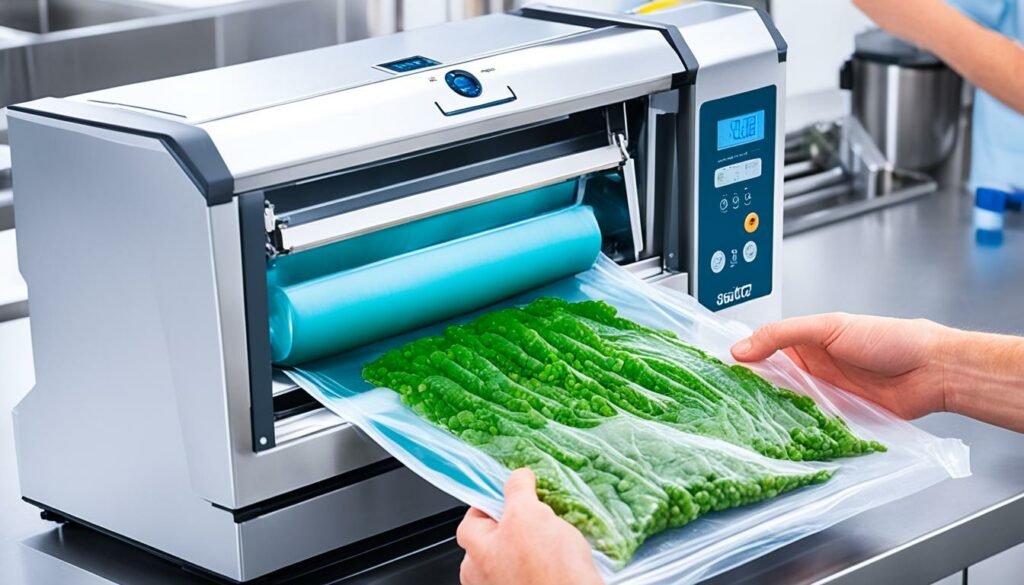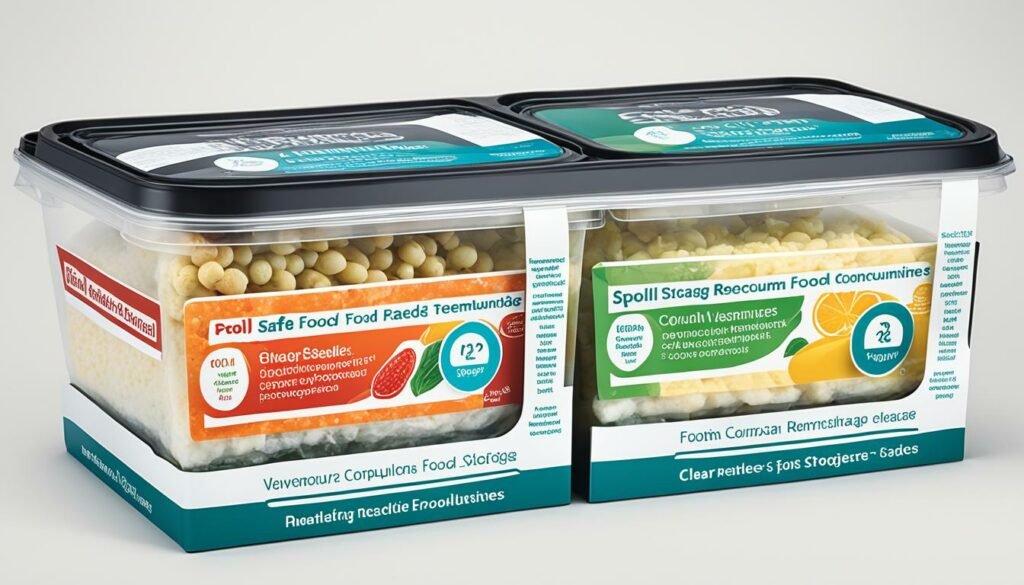I’m always on the lookout for the best ways to keep my food fresh and safe so, when it comes to food preservation methods, vacuum sealing and freezing often top the list. Both aim to extend shelf life, but they work in different ways. Vacuum sealing removes air from food, while freezing preserves food at low temperatures.
In this article, I’ll dive into the world of food safety, comparing these two popular methods. We’ll explore their benefits, potential risks, and best practices. By the end, you’ll have a clear understanding of how to choose the right preservation technique for your needs. Let’s get started on this journey to safer, longer-lasting food!
Introduction to Food Preservation Methods
Food preservation is essential for a safe and healthy kitchen. It significantly enhances our food storage and prevents foodborne illnesses. Understanding various preservation techniques is crucial.
Understanding the Importance of Food Safety
Food safety is paramount for our health. Proper food storage reduces harmful bacteria growth and extends grocery shelf life. This approach saves money and ensures we eat safe, nutritious meals.
Overview of Vacuum Sealing and Freezing
Vacuum sealing and freezing are top food preservation methods. Vacuum sealing removes air, slowing bacterial growth. Freezing halts bacterial activity by cooling food. Both methods are key to preventing foodborne illnesses.
Benefits of Proper Food Preservation
Effective food preservation methods bring numerous advantages. Let’s delve into some key benefits:
| Benefit | Vacuum Sealing | Freezing |
|---|---|---|
| Shelf Life Extension | 3-5 times longer | Up to 6 months or more |
| Food Quality | Maintains flavor and texture | Preserves nutrients |
| Storage Efficiency | Compact packaging | Organized freezer space |
| Food Waste Reduction | High | High |
By adopting these food storage best practices, we can enjoy fresher food for longer. This approach minimizes waste and safeguards our health.
The Science Behind Vacuum Sealing
Vacuum sealing is a leading-edge method for preserving food, utilizing reduced oxygen packaging to uphold food quality. This technique is intriguing, as it employs fundamental scientific principles to extend the shelf life of our food.
How Vacuum Sealing Works
Vacuum sealing eliminates air from food containers through suction. This action forms a tight seal, significantly diminishing oxygen levels. The absence of oxygen hampers the proliferation of bacteria and mold, thereby prolonging the food’s shelf life. Vacuum sealing can notably extend the storage duration of a variety of foods, from meats to vegetables.

Advantages of Reduced Oxygen Packaging
Reduced oxygen packaging presents numerous benefits:
- Extended shelf life
- Preserved food quality
- Reduced freezer burn
- Space-saving storage
These benefits render vacuum sealing a favored option for both home cooks and professionals in the food industry.
Potential Risks and Safety Concerns
Vacuum sealing is generally safe, yet it’s essential to recognize potential risks. The primary concern is the proliferation of anaerobic bacteria like Clostridium botulinum in environments with low oxygen. To avert this risk, I always refrigerate or freeze vacuum-sealed items promptly.
| Food Type | Vacuum Sealing Suitability | Safety Precautions |
|---|---|---|
| Meats | Suitable | Freeze immediately |
| Vegetables | Suitable | Blanch before sealing |
| Raw Onions | Not Recommended | N/A |
| Fresh Mushrooms | Not Recommended | N/A |
Food Safety: Vacuum Sealing vs. Freezing
When considering food preservation, vacuum sealing and freezing stand out as top choices. Each method brings distinct advantages for keeping perishable items fresh. Let’s delve into how these approaches differ in effectiveness, their effects on food quality, and safety aspects.
Comparison of Preservation Effectiveness
Vacuum sealing eliminates air from food, which hinders oxidation and mold growth. Freezing, by reducing temperature, slows bacterial expansion. My experience shows that using both methods together can significantly enhance preservation outcomes for extended storage.
| Method | Preservation Mechanism | Typical Shelf Life |
|---|---|---|
| Vacuum Sealing | Air removal | 1-2 weeks (refrigerated) |
| Freezing | Temperature reduction | 3-6 months |
| Vacuum Sealing + Freezing | Air removal + Temperature reduction | 6-12 months |
Impact on Food Quality and Shelf Life
Vacuum sealing is key in preserving food texture and taste by preventing freezer burn. Freezing, while effective, can sometimes alter the texture of fruits and vegetables. Combining both methods often leads to better quality and a longer shelf life.
Safety Considerations for Both Methods
Ensuring safe food handling is vital for both vacuum sealing and freezing. I always keep vacuum-sealed items refrigerated below 41°F or frozen. Labeling with dates is crucial for tracking freshness. Freezing acts as an extra barrier against bacteria, but it doesn’t eliminate existing bacteria. Hence, the initial quality of food and proper handling are critical.
Best Practices for Safe Food Storage
When it comes to food storage, I always focus on safety and quality. Keeping the refrigerator at a temperature below 41°F is essential for food freshness. I regularly check the fridge’s temperature to ensure it stays within the safe range.
For vacuum-sealed foods, I adhere to the 14-day rule. I use these foods within two weeks or freeze them for extended periods. This approach helps maintain their quality and safety.

Labeling is vital for safe food handling. I clearly mark packages with “keep refrigerated” or “keep frozen” and include use-by dates. This method aids in tracking freshness and preventing foodborne illnesses. When dealing with vacuum-sealed fish, I remove it from packaging before thawing to avoid botulism risks.
To maintain food quality, I’ve developed a personal HACCP (Hazard Analysis Critical Control Points) plan. This system aids in identifying potential hazards and implementing control measures. I continually update my knowledge on the latest food safety procedures to refine my storage practices.
- Keep refrigerator below 41°F
- Label packages with storage instructions and dates
- Use vacuum-sealed foods within 14 days or freeze
- Remove vacuum-sealed fish from packaging before thawing
- Develop and follow a personal HACCP plan
By adhering to these guidelines, I ensure my stored food remains safe, fresh, and of high quality. Remember, proper food storage is crucial for both the longevity and safety of your food. It’s also key to enjoying your meals to the fullest.
No products found.
Conclusion
I’ve delved into the realm of food preservation, comparing vacuum sealing with freezing. Both methods are essential for maintaining food freshness and safety. Vacuum sealing eliminates air, thereby slowing down spoilage. Freezing, on the other hand, arrests bacterial growth. The choice between them depends on the food type and desired storage duration.
Ensuring food safety is paramount when employing these preservation techniques. Adhering to proper handling and storage protocols is vital to avert foodborne illnesses. By grasping the science behind vacuum sealing and traditional storage methods, we can select the most suitable preservation strategies for our food.
Ultimately, vacuum sealing and freezing stand as pivotal in our arsenal of food preservation. Integrating these with stringent food safety measures enables us to prolong food shelf life, minimize waste, and savor fresh, wholesome meals for extended periods. For both home cooks and food aficionados, mastering these preservation techniques can significantly enhance grocery efficiency and kitchen productivity.
FAQ
What is the difference between vacuum sealing and freezing as food preservation methods?
Vacuum sealing removes oxygen from food packages, which slows down bacterial growth. Freezing, on the other hand, preserves food at low temperatures, effectively halting bacterial growth. Both methods aim to extend the shelf life and maintain food quality. However, they operate through distinct mechanisms.
What are the advantages of vacuum sealing?
Vacuum sealing offers several benefits. It reduces dehydration, extends the shelf life, and preserves food quality by eliminating oxygen from the package. These factors contribute to maintaining the freshness and nutritional value of the food.
What are the potential risks associated with vacuum sealing?
There are potential risks with vacuum sealing. For instance, anaerobic bacteria like Clostridium botulinum can grow in the absence of oxygen. Therefore, it is crucial to store vacuum-sealed foods in a refrigerated or frozen state. Certain foods, such as raw onions, fresh mushrooms, and garlic, should not be vacuum sealed due to the risk of botulinum toxin production.
How does the effectiveness of vacuum sealing compare to freezing?
Vacuum sealing and freezing are both effective preservation methods, but they impact food quality differently. Vacuum sealing reduces oxidation and dehydration, which helps maintain the texture and flavor of food. Freezing, by halting bacterial growth, also preserves food but may affect its texture and nutritional content. The effectiveness of each method depends on the specific food item being preserved.
What safety considerations should be followed when using vacuum sealing and freezing?
When using vacuum sealing and freezing, it is essential to follow certain safety guidelines. Ensure that refrigerated items are kept at temperatures below 41°F. Label packages clearly with “keep refrigerated” or “keep frozen” instructions. Always adhere to the use-by dates and follow specific guidelines for vacuum-sealed foods. For example, remove vacuum-sealed fish from packaging before thawing to prevent botulism.
What are some best practices for safe food storage when using vacuum sealing or freezing?
For safe food storage, consider developing and maintaining an HACCP plan for facilities using vacuum sealing. Ensure that employees are well-trained in food safety procedures. Implement safe storage practices, such as maintaining proper temperatures, labeling packages, and adhering to use-by dates. These measures help ensure the quality and safety of the stored food.
Source Links
- https://www.canr.msu.edu/news/vacuum-sealed-food-what-are-the-food-safety-concerns
- https://www.fns.usda.gov/fs/produce-safety/vacuum-seal
- https://www.hamiltoncountyhealth.org/wp-content/uploads/vacuum_sealing.pdf
Last update on 2025-10-30 / Affiliate links / Images from Amazon Product Advertising API
